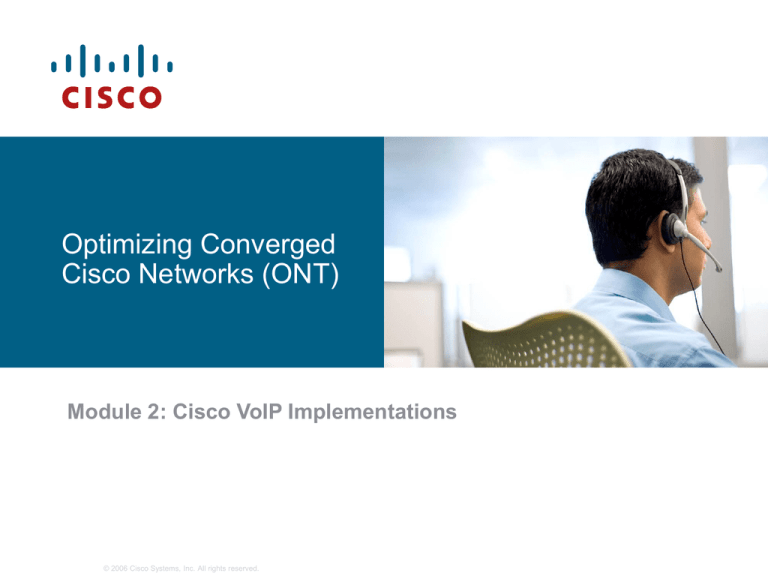
Optimizing Converged
Cisco Networks (ONT)
Module 2: Cisco VoIP Implementations
© 2006 Cisco Systems, Inc. All rights reserved.
Lesson 2.5:
Implementing VoIP in
an Enterprise
Network
© 2006 Cisco Systems, Inc. All rights reserved.
Objectives
List the common components of an enterprise voice
implementation.
Describe Call Admission Control and how it differs from
QoS.
Describe the functions of the Cisco Unified
CallManager.
Identify common enterprise IP telephony deployment
models.
Identify basic Cisco IOS VoIP configuration commands.
© 2006 Cisco Systems, Inc. All rights reserved.
Enterprise Voice Implementations
Components of enterprise voice networks:
Gateways and gatekeepers
Cisco Unified CallManager and IP phones
© 2006 Cisco Systems, Inc. All rights reserved.
Deploying CAC
CAC artificially limits the number of concurrent voice calls.
CAC prevents oversubscription of WAN resources caused by too much voice traffic.
CAC is needed because QoS cannot solve the problem of voice call
oversubscription:
QoS gives priority only to certain packet types (RTP versus data).
QoS cannot block the setup of too many voice calls.
Too much voice traffic results in delayed voice packets.
© 2006 Cisco Systems, Inc. All rights reserved.
Example: CAC Deployment
IP network (WAN) is only designed for two concurrent voice calls.
If CAC is not deployed, a third call can be set up, causing poor
quality for all calls.
When CAC is deployed, the third call is blocked.
© 2006 Cisco Systems, Inc. All rights reserved.
Voice Gateway Functions on a Cisco Router
Connects traditional telephony devices to VoIP
Converts analog signals to digital format
Encapsulates voice into IP packets
Performs voice compression
Provides DSP resources for conferencing and
transcoding
Supports fallback scenarios for IP phones (Cisco
SRST)
Acts as a call agent for IP phones (Cisco Unified
CallManager Express)
Provides DTMF relay and fax and modem support
© 2006 Cisco Systems, Inc. All rights reserved.
Cisco Unified CallManager Functions
Call processing
Dial plan administration
Signaling and device control
Phone feature administration
Directory and XML services
Programming interface to external applications
© 2006 Cisco Systems, Inc. All rights reserved.
Cisco IP Communicator
Example: Signaling and Call Processing
© 2006 Cisco Systems, Inc. All rights reserved.
Enterprise IP Telephony Deployment Models
Deployment Model
Single site
Characteristics
– Cisco Unified CallManager cluster at the single site
– Local IP phones only
Multisite with centralized
call processing
– Cisco Unified CallManager cluster only at a single
site
– Local and remote IP phones
Multisite with distributed call
processing
– Cisco Unified CallManager clusters at multiple sites
Clustering over WAN
– Single Cisco Unified CallManager cluster distributed
over multiple sites
– Local IP phones only
– Usually local IP phones only
– Requirement: Round-trip delay between any pair of
servers not to exceed 40 ms
© 2006 Cisco Systems, Inc. All rights reserved.
Single Site
Cisco Unified CallManager
servers, applications, and DSP
resources are located at the
same physical location.
IP WAN is not used for voice.
PSTN is used for all external
calls.
Note: Cisco Unified
CallManager cluster can be
connected to various places
depending on the topology.
© 2006 Cisco Systems, Inc. All rights reserved.
Multisite with Centralized Call Processing
Cisco Unified CallManager servers and applications are located at the central site
while DSP resources are distributed.
IP WAN carries data and voice (signaling for all calls, media only for intersite calls).
PSTN access is provided at all sites.
CAC is used to limit the number of VoIP calls, and AAR is used if WAN bandwidth is
exceeded.
Cisco SRST is located at the remote branch.
Note: Cisco Unified CallManager cluster can be connected to various places depending on
the topology.
© 2006 Cisco Systems, Inc. All rights reserved.
Multisite with Distributed Call Processing
Cisco Unified CallManager servers, applications, and DSP resources are located at
each site.
IP WAN carries data and voice for intersite calls only (signaling and media).
PSTN access is provided at all sites; rerouting to PSTN is configured if IP WAN is
down.
CAC is used to limit the number of VoIP calls, and AAR is used if WAN bandwidth is
exceeded.
Note: Cisco Unified CallManager cluster can be connected to various places, depending on
the topology.
© 2006 Cisco Systems, Inc. All rights reserved.
Clustering over WAN
Cisco Unified CallManager servers of a single cluster are distributed among multiple sites while
applications and DSP resources are located at each site.
Intracluster communication (such as database synchronization) is performed over
the WAN.
IP WAN carries data and voice for intersite calls only (signaling and media).
PSTN access is provided at all sites; rerouting to PSTN is performed if IP WAN is down.
CAC is used to limit the number of VoIP calls; AAR is used if WAN bandwidth is exceeded.
Note: Cisco Unified CallManager cluster can be connected to various places, depending on the topology.
© 2006 Cisco Systems, Inc. All rights reserved.
Basic Cisco IOS VoIP Voice Commands
© 2006 Cisco Systems, Inc. All rights reserved.
Voice-Specific Commands
router(config)#
dial-peer voice tag type
Use the dial-peer voice command to enter the dial peer subconfiguration mode.
router(config-dial-peer)#
destination-pattern telephone_number
The destination-pattern command, entered in dial peer subconfiguration mode,
defines the telephone number that applies to the dial peer.
© 2006 Cisco Systems, Inc. All rights reserved.
Voice-Specific Commands (Cont.)
router(config-dial-peer)#
port port-number
The port command, entered in POTS dial peer subconfiguration mode, defines the
port number that applies to the dial peer. Calls that are routed using this dial peer are
sent to the specified port.
router(config-dial-peer)#
session target ipv4:ip-address
The session target command, entered in VoIP dial peer subconfiguration mode,
defines the IP address of the target VoIP device that applies to the dial peer.
© 2006 Cisco Systems, Inc. All rights reserved.
Self Check
1. What is CAC?
2. What can happen is CAC is not used?
3. What command is used to define the telephone
number that applies to the dial peer?
4. List 4 deployment options when using the Cisco
Unified CallManager.
© 2006 Cisco Systems, Inc. All rights reserved.
Summary
Enterprise voice implementations use components
such as gateways, gatekeepers, Cisco Unified
CallManager, and IP phones.
Call Admission Control (CAC) extends the functionality
of QoS to ensure that an additional call is not allowed
unless bandwidth is available to support it.
Enterprise IP Telephony deployment models include
single site, multisite with centralized call processing,
multisite with distributed call processing, and clustering
over the WAN.
© 2006 Cisco Systems, Inc. All rights reserved.
Q and A
© 2006 Cisco Systems, Inc. All rights reserved.
Resources
Video: The ABCs of VoIP (16 min.)
http://tools.cisco.com/cmn/jsp/index.jsp?id=43596
Voice and Unified Communications
http://www.cisco.com/en/US/products/sw/voicesw/index.html
VoIP Call Admission Control
http://www.cisco.com/univercd/cc/td/doc/cisintwk/intsolns/voipso
l/cac.htm
© 2006 Cisco Systems, Inc. All rights reserved.
© 2006 Cisco Systems, Inc. All rights reserved.





